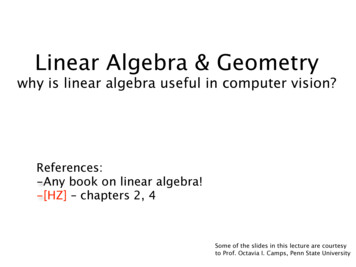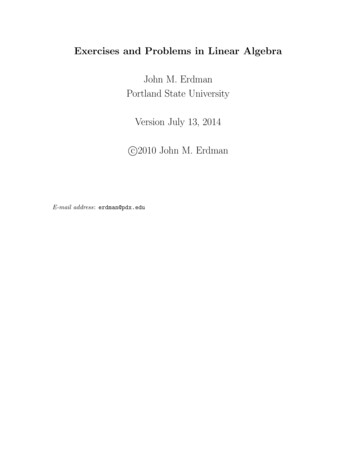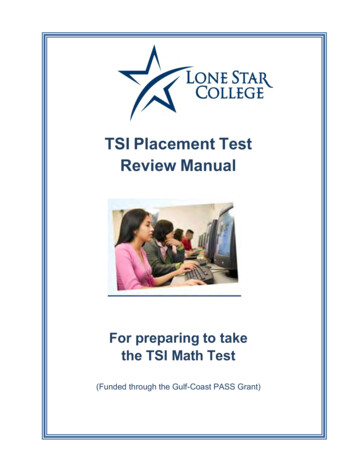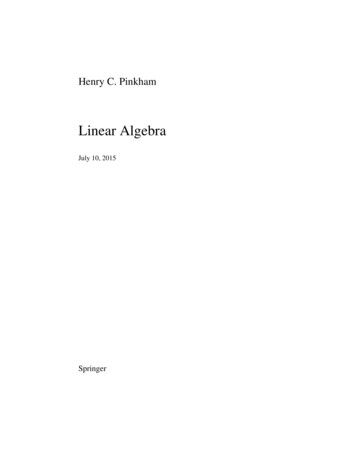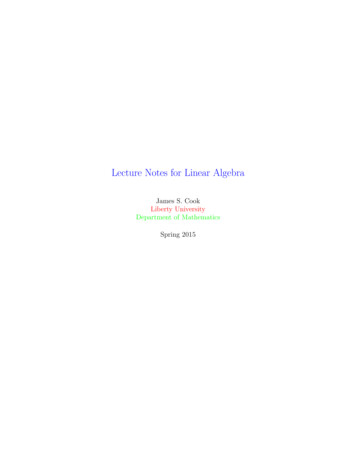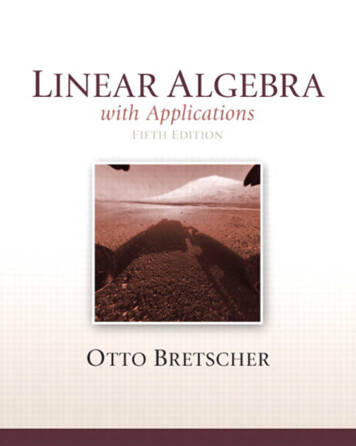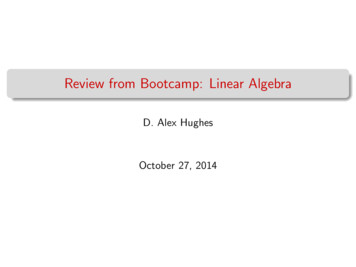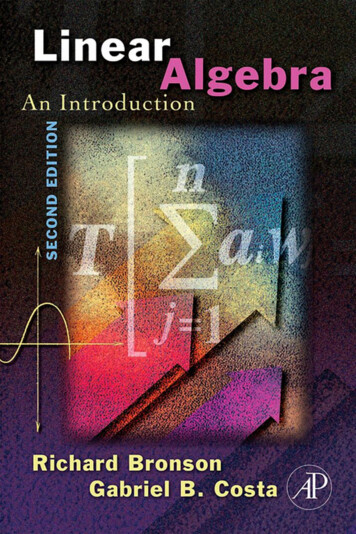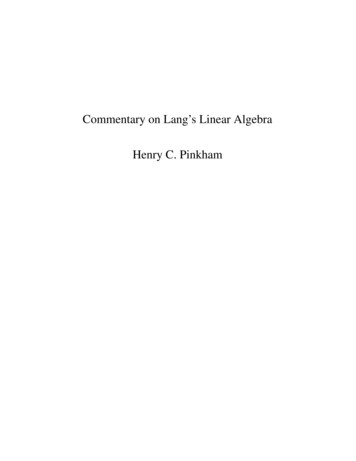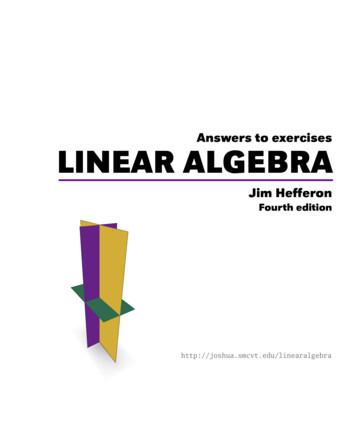
Transcription
Answers to exercisesLINEAR ALGEBRAJim HefferonFourth editionhttp://joshua.smcvt.edu/linearalgebra
NotationR, R , RnN, C(a . b), [a . b]h. . .ihi,jV, W, U v, 0, 0VPn , Mn m[S] δhB, Di, β,En h e1 , . . . , en i WV M Nh, gt, sRepB ( v), RepB,D (h)Zn m or Z, In n or I T R(h), N (h)R (h), N (h)real numbers, positive reals, n-tuples of realsnatural numbers { 0, 1, 2, . . . }, complex numbersopen interval, closed intervalsequence (a list in which order matters)row i and column j entry of matrix Hvector spacesvector, zero vector, zero vector of a space Vspace of degree n polynomials, n m matricesspan of a setbasis, basis vectorsstandard basis for Rnisomorphic spacesdirect sum of subspaceshomomorphisms (linear maps)transformations (linear maps from a space to itself)representation of a vector, a mapzero matrix, identity matrixdeterminant of the matrixrange space, null space of the mapgeneralized range space and null spaceGreek letters with pronounciationcharacterαβγ, Γδ, ζηθ, Θικλ, Λµnamealpha AL-fuhbeta BAY-tuhgamma GAM-muhdelta DEL-tuhepsilon EP-suh-lonzeta ZAY-tuheta AY-tuhtheta THAY-tuhiota eye-OH-tuhkappa KAP-uhlambda LAM-duhmu MEWcharacterνξ, Ξoπ, Πρσ, Στυ, Υφ, Φχψ, Ψω, Ωnamenu NEWxi KSIGHomicron OM-uh-CRONpi PIErho ROWsigma SIG-muhtau TOW (as in cow)upsilon OOP-suh-LONphi FEE, or FI (as in hi)chi KI (as in hi)psi SIGH, or PSIGHomega oh-MAY-guhCapitals shown are the ones that differ from Roman capitals.
PrefaceThese are answers to the exercises in Linear Algebra by J Hefferon. An answerlabeled here as One.II.3.4 is for the question numbered 4 from the first chapter, secondsection, and third subsection. The Topics are numbered separately.If you have an electronic version of this file then save it in the same directory asthe book. That way, clicking on the question number in the book takes you to itsanswer and clicking on the answer number takes you to the question. (The book’s filemust be named ‘book.pdf’ and this answer file must be named ‘jhanswer.pdf’. Youcannot rename these files, due to the PDF language.)I welcome bug reports and comments. Contact information is on the book’s homepage http://joshua.smcvt.edu/linearalgebra.Jim HefferonSaint Michael’s College, Colchester VT USA2020-Apr-26
ContentsLinear SystemsSection I: Solving Linear Systems . . . . . . . .One.I.1: Gauss’s Method . . . . . . . . . . . .One.I.2: Describing the Solution Set . . . . .One.I.3: General Particular HomogeneousSection II: Linear Geometry . . . . . . . . . . .One.II.1: Vectors in Space . . . . . . . . . . .One.II.2: Length and Angle Measures . . . .Section III: Reduced Echelon Form . . . . . . .One.III.1: Gauss-Jordan Reduction . . . . . .One.III.2: The Linear Combination Lemma .Topic: Computer Algebra Systems . . . . . . .Topic: Input-Output Analysis . . . . . . . . . .Topic: Accuracy of Computations . . . . . . . .Topic: Analyzing Networks . . . . . . . . . . . .Vector SpacesSection I: Definition of Vector Space . . . . . .Two.I.1: Definition and Examples . . . . . . .Two.I.2: Subspaces and Spanning Sets . . . .Section II: Linear Independence . . . . . . . . .Two.II.1: Definition and Examples . . . . . .Section III: Basis and Dimension . . . . . . . .Two.III.1: Basis . . . . . . . . . . . . . . . . .Two.III.2: Dimension . . . . . . . . . . . . . .Two.III.3: Vector Spaces and Linear Systems. 63. 63. 73. 84. 84. 96. 96. 106. 1141191824242738384450545657
ivLinear Algebra, by HefferonTwo.III.4: Combining SubspacesTopic: Fields . . . . . . . . . . . . .Topic: Crystals . . . . . . . . . . .Topic: Voting Paradoxes . . . . . .Topic: Dimensional Analysis . . . .124129130131134Maps Between SpacesSection I: Isomorphisms . . . . . . . . . . . . . . . . .Three.I.1: Definition and Examples . . . . . . . . . .Three.I.2: Dimension Characterizes Isomorphism . .Section II: Homomorphisms . . . . . . . . . . . . . . .Three.II.1: Definition . . . . . . . . . . . . . . . . . .Three.II.2: Range Space and Null Space . . . . . . .Section III: Computing Linear Maps . . . . . . . . . .Three.III.1: Representing Linear Maps with MatricesThree.III.2: Any Matrix Represents a Linear Map . .Section IV: Matrix Operations . . . . . . . . . . . . . .Three.IV.1: Sums and Scalar Products . . . . . . . .Three.IV.2: Matrix Multiplication . . . . . . . . . .Three.IV.3: Mechanics of Matrix Multiplication . . .Three.IV.4: Inverses . . . . . . . . . . . . . . . . . .Section V: Change of Basis . . . . . . . . . . . . . . . .Three.V.1: Changing Representations of Vectors . .Three.V.2: Changing Map Representations . . . . .Section VI: Projection . . . . . . . . . . . . . . . . . .Three.VI.1: Orthogonal Projection Into a Line . . .Three.VI.2: Gram-Schmidt Orthogonalization . . . .Three.VI.3: Projection Into a Subspace . . . . . . .Topic: Line of Best Fit . . . . . . . . . . . . . . . . . .Topic: Geometry of Linear Maps . . . . . . . . . . . .Topic: Magic Squares . . . . . . . . . . . . . . . . . . .Topic: Markov Chains . . . . . . . . . . . . . . . . . .Topic: Orthonormal Matrices . . . . . . . . . . . . . 33241241246259269274278279289DeterminantsSection I: Definition . . . . . . . . . . . .Four.I.1: Exploration . . . . . . . . . .Four.I.2: Properties of Determinants .Four.I.3: The Permutation Expansion.291291295299.
Answers to ExercisesFour.I.4: Determinants Exist . . . . . . .Section II: Geometry of Determinants . . . .Four.II.1: Determinants as Size FunctionsSection III: Laplace’s Formula . . . . . . . .Four.III.1: Laplace’s Expansion . . . . . .Topic: Cramer’s Rule . . . . . . . . . . . . .Topic: Speed of Calculating Determinants .Topic: Chiò’s Method . . . . . . . . . . . . .Topic: Projective Geometry . . . . . . . . .Topic: Computer Graphics . . . . . . . . . .i.305307307314314319321321323327SimilaritySection I: Complex Vector Spaces . . . . . . . .Section II: Similarity . . . . . . . . . . . . . . .Five.II.1: Definition and Examples . . . . . .Five.II.2: Diagonalizability . . . . . . . . . . .Five.II.3: Eigenvalues and Eigenvectors . . .Section III: Nilpotence . . . . . . . . . . . . . .Five.III.1: Self-Composition . . . . . . . . . .Five.III.2: Strings . . . . . . . . . . . . . . . .Section IV: Jordan Form . . . . . . . . . . . . .Five.IV.1: Polynomials of Maps and MatricesFive.IV.2: Jordan Canonical Form . . . . . .Topic: Method of Powers . . . . . . . . . . . . .Topic: Stable Populations . . . . . . . . . . . .Topic: Page Ranking . . . . . . . . . . . . . . .Topic: Linear Recurrences . . . . . . . . . . . .Topic: Coupled Oscillators . . . . . . . . . . . .329329329337345356356358365365375387389391392395
iiLinear Algebra, by Hefferon
Chapter OneLinear SystemsSection I: Solving Linear SystemsOne.I.1: Gauss’s MethodOne.I.1.17(a) Gauss’s Method2x 3y 13 (5/2)y 15/2gives that the solution is y 3 and x 2.(b) Gauss’s Method here (1/2)ρ1 ρ2 x z 0y 3z 1ρ1 ρ3y 4gives x 1, y 4, and z 1. 3ρ1 ρ2 x ρ2 ρ3 z 0y 3z 1 3z 3One.I.1.18 If a system has a contradictory equation then it has no solution. Otherwise,if there are any variables that are not leading a row then it has infinitely manysolution. In the final case, where there is no contradictory equation and everyvariable leads some row, it has a unique solution.(a) Unique solution(b) Infinitely many solutions(c) Infinitely many solutions(d) No solution(e) Infinitely many solutions(f) Infinitely many solutions(g) No solution(h) Infinitely many solutions
2Linear Algebra, by Hefferon(i) No solution(j) Unique solutionOne.I.1.19 (a) Gaussian reduction2x 2y 5 5y 5/2shows that y 1/2 and x 2 is the unique solution.(b) Gauss’s Methodρ1 ρ2 x y 1 2y 3gives y 3/2 and x 1/2 as the only solution.(c) Row reduction ρ1 ρ2 x 3y z 1 4y z 13shows, because the variable z is not a leading variable in any row, that there aremany solutions.(d) Row reduction 3ρ1 ρ2 x y 1 0 1shows that there is no solution.(e) Gauss’s Methodx y z 10x y z 10 4y 3z 20ρ1 ρ4 2x 2y z 0 2ρ1 ρ2 ρ ρ13x z 5 y 2z 54y z 204y z 20 (1/2)ρ1 ρ2 x (1/4)ρ2 ρ3 ρ2 ρ4y 4y z 103z 20(5/4)z 04z 0gives the unique solution (x, y, z) (5, 5, 0).(f) Here Gauss’s Method gives2x z w 5y w 1 (3/2)ρ1 ρ3 2ρ1 ρ4 (5/2)z (5/2)w 15/2y w 12xz w 5 w 1 (5/2)z (5/2)w 15/20 0which shows that there are many solutions. ρ2 ρ4 y
Answers to ExercisesOne.I.1.203(a) Gauss’s Methodx y z 5x y 0y 2z 7 ρ1 ρ2 x y z 50 2y z 5y 2z 7x y z 50 2y 1 5 (3/2)z 7/2(3/2)ρ2 ρ3 followed by back-substitution gives x 1, y 1, and z 3.(b) Here Gauss’s Method3x z 7x y 3z 4x 2y 5z 13x (1/3)ρ1 ρ2 (1/3)ρ1 ρ33x2ρ2 ρ3 z 7 y (8/3)z 5/32y (16/3)z (10/3) z 7 y (8/3)z 5/30 0finds that the variable z does not lead a row. There are infinitely many solutions.(c) The stepsx 3y z 0 x y 2 x y 2z 8ρ1 ρ2 ρ1 ρ3x 3y z 02y z 24y 3z 8 2ρ2 ρ3 x 3y z 02y z 2z 4give (x, y, z) ( 1, 1, 4).One.I.1.21 (a) From x 1 3y we get that 2(1 3y) y 3, giving y 1.(b) From x 1 3y we get that 2(1 3y) 2y 0, leading to the conclusionthat y 1/2.Users of this method must check any potential solutions by substituting backinto all the equations.One.I.1.22 Do the reduction 3ρ1 ρ2 x y 10 3 kto conclude this system has no solutions if k 6 3 and if k 3 then it has infinitelymany solutions. It never has a unique solution.One.I.1.23 Let x sin α, y cos β, and z tan γ:2x y 3z 34x 2y 2z 106x 3y z 9 2ρ1 ρ2 3ρ1 ρ32x y 3z 34y 8z 4 8z 0gives z 0, y 1, and x 2. Note that no α R satisfies that sin α 2.
4Linear Algebra, by HefferonOne.I.1.24(a) Gauss’s Methodx 3y b1x 3y b110y 3b1 b2 ρ2 ρ310y 3b1 b2 3ρ1 ρ2 ρ1 ρ310y b1 b3 ρ2 ρ40 2b1 b2 b3 2ρ1 ρ410y 2b1 b40 b1 b2 b4shows that this system is consistent if and only if both b3 2b1 b2 andb4 b1 b2 .(b) Reductionx1 2x2 3x3 b1 2ρ1 ρ2 x2 3x3 2b1 b2 ρ1 ρ3 2x2 5x3 b1 b3x1 2x2 3x3 b1x2 3x3 2b1 b2 x3 5b1 2b2 b3shows that each of b1 , b2 , and b3 can be any real number — this system alwayshas a unique solution.One.I.1.25 This system with more unknowns than equationsx y z 0x y z 1has no solution.One.I.1.26 Yes. For example, the fact that we can have the same reaction in twodifferent flasks shows that twice any solution is another, different, solution (if aphysical reaction occurs then there must be at least one nonzero solution).One.I.1.27 Because f(1) 2, f( 1) 6, and f(2) 3 we get a linear system.1a 1b c 21a 1b c 64a 2b c 3Gauss’s Methoda b c 2a b c 2 ρ1 ρ2 ρ2 ρ3 2b 4 2b 4 4ρ1 ρ3 2b 3c 5 3c 9shows that the solution is f(x) 1x2 2x 3.One.I.1.28 Here S0 {(1, 1) }x y 2 0ρ2 x y 2 x y 00 0while S1 is a proper superset because it contains at least two points: (1, 1) and (2, 0).In this example the solution set does not change.x y 2 0ρ2 x y 2 2x 2y 40 02ρ2 ρ3
Answers to Exercises5One.I.1.29 (a) Yes, by inspection the given equation results from ρ1 ρ2 .(b) No. The pair (1, 1) satisfies the given equation. However, that pair does notsatisfy the first equation in the system.(c) Yes. To see if the given row is c1 ρ1 c2 ρ2 , solve the system of equationsrelating the coefficients of x, y, z, and the constants:2c1 6c2 6c1 3c2 9 c1 c2 54c1 5c2 2and get c1 3 and c2 2, so the given row is 3ρ1 2ρ2 .One.I.1.30 If a 6 0 then the solution set of the first equation is this.{(x, y) R2 x (c by)/a (c/a) (b/a) · y }( )Thus, given y we can compute the associated x. Taking y 0 gives the solution(c/a, 0), and since the second equation ax dy e is supposed to have the samesolution set, substituting into it gives that a(c/a) d · 0 e, so c e. Takingy 1 in ( ) gives a((c b)/a) d · 1 e, and so b d. Hence they are the sameequation.When a 0 the equations can be different and still have the same solutionset: e.g., 0x 3y 6 and 0x 6y 12.One.I.1.31 We take three cases: that a 6 0, that a 0 and c 6 0, and that botha 0 and c 0.For the first, we assume that a 6 0. Then the reductionby j (c/a)ρ1 ρ2 ax ( (cb/a) d)y (cj/a) kshows that this system has a unique solution if and only if (cb/a) d 6 0;remember that a 6 0 so that back substitution yields a unique x (observe, by theway, that j and k play no role in the conclusion that there is a unique solution,although if there is a unique solution then they contribute to its value). But (cb/a) d (ad bc)/a and a fraction is not equal to 0 if and only if itsnumerator is not equal to 0. Thus, in this first case, there is a unique solution ifand only if ad bc 6 0.In the second case, if a 0 but c 6 0, then we swapcx dy kby jto conclude that the system has a unique solution if and only if b 6 0 (we usethe case assumption that c 6 0 to get a unique x in back substitution). But —where a 0 and c 6 0 — the condition “b 6 0” is equivalent to the condition“ad bc 6 0”. That finishes the second case.
6Linear Algebra, by HefferonFinally, for the third case, if both a and c are 0 then the system0x by j0x dy kmight have no solutions (if the second equation is not a multiple of the first) or itmight have infinitely many solutions (if the second equation is a multiple of thefirst then for each y satisfying both equations, any pair (x, y) will do), but it neverhas a unique solution. Note that a 0 and c 0 gives that ad bc 0.One.I.1.32 Recall that if a pair of lines share two distinct points then they are thesame line. That’s because two points determine a line, so these two points determineeach of the two lines, and so they are the same line.Thus the lines can share one point (giving a unique solution), share no points(giving no solutions), or share at least two points (which makes them the sameline).One.I.1.33 For the reduction operation of multiplying ρi by a nonzero real number k,we have that (s1 , . . . , sn ) satisfies this systema1,1 x1 a1,2 x2 · · · a1,n xn d1.kai,1 x1 kai,2 x2 · · · kai,n xn kdi.am,1 x1 am,2 x2 · · · am,n xn dmif and only if a1,1 s1 a1,2 s2 · · · a1,n sn d1 and . . . kai,1 s1 kai,2 s2 · · · kai,n sn kdi and . . . am,1 s1 am,2 s2 · · · am,n sn dm by the definition of‘satisfies’. Because k 6 0, that’s true if and only if a1,1 s1 a1,2 s2 · · · a1,n sn d1and . . . ai,1 s1 ai,2 s2 · · · ai,n sn di and . . . am,1 s1 am,2 s2 · · · am,n sn dm (this is straightforward canceling on both sides of the i-th equation), whichsays that (s1 , . . . , sn ) solvesa1,1 x1 a1,2 x2 · · · a1,n xn d1.ai,1 x1 ai,2 x2 · · · ai,n xn di.am,1 x1 am,2 x2 · · · am,n xn dmas required.
Answers to Exercises7For the combination operation kρi ρj , the tuple (s1 , . . . , sn ) satisfiesa1,1 x1 · · · a1,n xn .ai,1 x1 · · · ai,n xn .(kai,1 aj,1 )x1 · · · (kai,n aj,n )xn .am,1 x1 · · · am,n xn d1dikdi djdmif and only if a1,1 s1 · · · a1,n sn d1 and . . . ai,1 s1 · · · ai,n sn diand . . . (kai,1 aj,1 )s1 · · · (kai,n aj,n )sn kdi dj and . . . am,1 s1 am,2 s2 · · · am,n sn dm again by the definition of ‘satisfies’. Subtract ktimes the equation i from equation j. (Here is where we need i 6 j; if i j thenthe two di ’s above are not equal.) The previous compound statement holds ifand only if a1,1 s1 · · · a1,n sn d1 and . . . ai,1 s1 · · · ai,n sn di and. . .(kai,1 aj,1 )s1 · · · (kai,n aj,n )sn (kai,1 s1 · · · kai,n sn ) kdi dj kdiand. . . am,1 s1 · · · am,n sn dm , which after cancellation says that (s1 , . . . , sn )solvesa1,1 x1 · · · a1,n xn d1.ai,1 x1 · · · ai,n xn di.aj,1 x1 · · · aj,n xn dj.am,1 x1 · · · am,n xn dmas required.One.I.1.34 Yes, this one-equation system:0x 0y 02is satisfied by every (x, y) R .One.I.1.35 Yes. This sequence of operations swaps rows i and jρi ρj ρj ρi ρi ρj 1ρi so the row-swap operation is redundant in the presence of the other two.One.I.1.36 Reverse a row swap ρi ρj by swapping back ρj ρi . Reverse the kρistep of multiplying k 6 0 on both sides of a row by dividing through (1/k)ρi .
8Linear Algebra, by HefferonThe row combination case is the nontrivial one. The operation kρi ρj resultsin this j-th row.k · ai,1 aj,1 · · · k · ai,n aj,n k · di djThe i-th row unchanged because of the i 6 j restriction. Because the i-th row isunchanged, the operation kρi ρj returns the j-th row to its original state.(Observe that the i j condition on the kρi ρj is needed, or else this couldhappen3x 2y 72ρ1 ρ1 9x 6y 21 2ρ1 ρ1 9x 6y 21and so the result wouldn’t hold.)One.I.1.37 Let p, n, and d be the number of pennies, nickels, and dimes. For variablesthat are real numbers, this systemp n d 13 ρ1 ρ2 p n d 13 p 5n 10d 834n 9d 70has more than one solution; in fact, it has infinitely many of them. However, ithas a limited number of solutions in which p, n, and d are non-negative integers.Running through d 0, . . . , d 8 shows that (p, n, d) (3, 4, 6) is the onlysolution using natural numbers.One.I.1.38 Solving the system(1/3)(a b c) d 29(1/3)(b c d) a 23(1/3)(c d a) b 21(1/3)(d a b) c 17we obtain a 12, b 9, c 3, d 21. Thus the second item, 21, is the correctanswer.One.I.1.39 This is how the answer was given in the cited source. A comparisonof the units and hundreds columns of this addition shows that there must be acarry from the tens column. The tens column then tells us that A H, so therecan be no carry from the units or hundreds columns. The five columns then givethe following five equations.A E W2H A 10H W 1H T E 10A 1 TThe five linear equations in five unknowns, if solved simultaneously, produce theunique solution: A 4, T 5, H 7, W 6 and E 2, so that the originalexample in addition was 47474 5272 52746.
Answers to Exercises9One.I.1.40 This is how the answer was given in the cited source. Some additionalmaterial was added from [joriki]. Eight commissioners voted for B. To see this,we will use the given information to study how many voters chose each order of A,B, C.The six orders of preference are ABC, ACB, BAC, BCA, CAB, CBA; assumethey receive a, b, c, d, e, f votes respectively. We know thata b e 11d e f 12a c d 14from the number preferring A over B, the number preferring C over A, and thenumber preferring B over C. Because 20 votes were cast, a b · · · f 20.Subtracting the sum of the three above equations from twice the prior equationgives b c f 3. We’ve specified that each preference order got at least one vote,so that means b c f 1.From the above three equations the complete solution is then a 6, b 1,c 1, d 7, e 4, and f 1, as we can find with Gauss’s Method. The numberof commissioners voting for B as their first choice is therefore c d 1 7 8.Comments. The answer to this question would have been the same had we knownonly that at least 14 commissioners preferred B over C.The seemingly paradoxical nature of the commissioner’s preferences (A is preferred to B, and B is preferred to C, and C is preferred to A), an example of“non-transitive dominance”, is common when individual choices are pooled.One.I.1.41 This is how the answer was given in the cited source. We have notused “dependent” yet; it means here that Gauss’s Method shows that there isnot a unique solution. If n 3 the system is dependent and the solution is notunique. Hence n 3. But the term “system” implies n 1. Hence n 2. If theequations areax (a d)y a 2d(a 3d)x (a 4d)y a 5dthen x 1, y 2.One.I.2: Describing the Solution SetOne.I.2.15(a) 2One.I.2.16(a) 2 3(b) 3(c) 1(b) 3 2(d) Not defined.(c) 2 2
10One.I.2.17Linear Algebra, by Hefferon 5 (a) 1 5 (b)20 5! 2 (c) 4 0(d)4152!(e) Not defined. 12 (f) 8 4One.I.2.18 (a) This reduction !!3 6 183 6 18( 1/3)ρ1 ρ2 1 260 00leaves x leading and y free. Making y the parameter, gives x 6 2y and thissolution set.!!6 2{ y y R}01(b) A reduction!!1 11 111 ρ1 ρ2 1 1 10 2 2gives the unique solution y 1, x 0. Thesolutionset is this.!0{}1(c) Gauss’s Method 1 0 11 0 1 441 0 1 4 ρ1 ρ2 ρ2 ρ3 5 1 1 2 0 1 1 1 0 1 1 1 4ρ1 ρ34 1 5 170 1 1 10 0 0 0leaves x1 and x2 leading withxfree.Thesolutionsetisthis.3 4 1 { 1 1 x3 x3 R }01(d) This reduction 2 1 1 221 12 ρ1 ρ2 1 3 121 2 0 0 (1/2)ρ1 ρ31 1 0 00 3/2 1/2 1 2 1 12( 3/2)ρ2 ρ3 21 0 10 0 5/2 5/2shows that the solution set is a singletonset. 1 { 1 }1
Answers to Exercises(e) This reduction is 1 2 2 11 111easy 101011 3 4 1 1 2 1 03 0 3 2 1 2 0 3 2 1 2 1 2 1 03 0 3 2 1 2 0 00 00 2ρ1 ρ2 ρ1 ρ3 ρ2 ρ3 and ends with x and y leading while z and w are free. Solving for y givesy (2 2z w)/3 and substitution shows that x 2(2 2z w)/3 z 3 sox (5/3) (1/3)z (2/3)w, making this the solution set. 5/3 1/3 2/3 2/3 2/3 1/3 { z w z, w R } 0 1 0 001(f) The reduction 1 0 2 13 11 10 11 0 4 2 7 2ρ1 ρ2 3ρ1 ρ3 ρ2 ρ3 1 00 1 000110101 2 21 201 3 31 30 4 6 5 4 6 1shows that there is no solution — the solution set is empty.One.I.2.19(a) The reduction241 1 1013! 2ρ1 ρ2 201 3 1211!ends with x and y leading, and with z free. Solving for y gives y (1 2z)/( 3),and then substitution 2x (1 2z)/( 3) z 1 shows that x ((4/3) (1/3)z)/2.Hence the solution set is this. 2/31/6 { 1/3 2/3 z z R}01
12Linear Algebra, by Hefferon(b) This application 1 0 0 11 2of Gauss’s Method 1 1 0 1 ρ1 ρ3 2 1 3 03 1 70 1 2ρ2 ρ3 00012010 124 120 1 3 6 0 1 1 3 1 00 1 1leaves x, y, and w leading. The solution set is here. 11 3 2 { z z R} 0 1 00(c) This row reduction 1 1 1 0 0 1 0 1 3 2 3 10 1 0 1 00 0 0 1 1 1 0 0 1 0 1 0 3ρ1 ρ3 0 0 1 0 1 0 0 1 0 1 0 1 1 1 0 0 1 0 1 0 ρ2 ρ3 0 ρ2 ρ4 0 0 0 0 0 0 0 0 0 0ends with z and w free.Wehavethissolution set.0 1 1 0 0 1 { z w z, w R } 0 1 0 001(d) Gauss’s Method done in this way!1 2 3 1 1 1 3ρ1 ρ2 3 1 1 1 1 3102 73 81 2 1410!ends with c, d, and e free. Solving for b shows that b (8c 2d 4e)/( 7)and then substitution a 2(8c 2d 4e)/( 7) 3c 1d 1e 1 shows thata 1 (5/7)c (3/7)d (1/7)e and we have the solution set. 1 5/7 3/7 1/7 0 8/7 2/7 4/7 { 0 1 c 0 d 0 e c, d, e R } 0 0 1 0 0001
Answers to ExercisesOne.I.2.2013(a) This reduction 3 2 1 1 1 1 1 2 5 5 1 0 3 002 5/35/32 5/3012/30 (1/3)ρ1 ρ2 (5/3)ρ1 ρ3ρ2 ρ3 3 00 11 2/35/3 2/3 5/3 1 5/3 0gives this solution set. x1 3/5 { y 1 2/5 z z R}z01(b) This is the reduction. 1 1 2 1 1 0 3 1 20 2 2 03 6 3 ρ1 ρ2 3ρ1 ρ3 2ρ2 ρ3 ρ2 ρ41 0 00 1 0 001 2 42 224 21 200 2200 0 3 6 3 0 3 0 0The solution set is this. 3/21 { 3/2 1 z z R }01(c) Gauss’s Method21 11 11104 1! (1/2)ρ1 ρ2 20 13/2 113/2 1/24 3!gives the solution set. (d) Here is 1 1 1 13 1the 20 2 10 1/3 2 1 1/3 { z w z, w R } 0 1 0 001reduction. 01 1 2 01 ρ1 ρ2 2ρ2 ρ3 3 0 2 2 3 0 3ρ1 ρ300 4 400The solution set is empty { }.1 20 220 0 3 6
14Linear Algebra, by HefferonOne.I.2.21 For each problem we get a system of linear equations by looking at theequations of components.(a) k 5(b) The second components show that i 2, the third components show thatj 1.(c) m 4, n 2One.I.2.22 For each problem we get a system of linear equations by looking at theequations of components.(a) Yes; take k 1/2.(b) No; the system with equations 5 5 · j and 4 4 · j has no solution.(c) Yes; take r 2.(d) No. The second components give k 0. Then the third components givej 1. But the first components don’t check.One.I.2.23 (a) Let c be the number of acres of corn, s be the number of acres of soy,and a be the number of acres of oats.c s a 1200 20ρ1 ρ2 c s a 1200 20c 50s 12a 40 00030s 8a 16 000To describe the solutionsetwecanparametrizeusing a.c20 000/30 38/30 { s 16 000/30 8/30 a a R }a01(b) There are many answers possible here. For instance we can take a 0 to getc 20 000/30 666.66 and s 16000/30 533.33. Another example is to takea 20 000/38 526.32, giving c 0 and s 7360/38 193.68.(c) Plug your answers from the prior part into 100c 300s 80a.One.I.2.24 This system has one equation. The leading variable is x1 , the othervariables are free. 1 1 1 0 { . x2 · · · . xn x2 , . . . , xn R} . . 01One.I.2.25(a)Gauss’sMethodheregives 1 2 0 1 a1 2 0 1a 2ρ1 ρ2 2 0 1 0 b ρ 0 4 1 2 2a b 1 ρ31 1 0 2 c0 1 0 3 a c 1 20 1a (1/4)ρ2 ρ3 12 2a b 0 4 0 0 1/4 5/2 (1/2)a (1/4)b c
Answers to Exercises15leaving w free. Solve: z 2a b 4c 10w, and 4y 2a b (2a b 4c 10w) 2w so y a c 3w, and x a 2(a c 3w) w a 2c 5w.Therefore the solution set is this. a 2c 5 a c 3 { w w R} 2a b 4c 10 01(b) Plug in with a 3, b 1, and c 2. 5 7 5 3 { w w R} 15 10 10One.I.2.26 Leaving the comma out, say by writing a123 , is ambiguous because itcould mean a1,23 or a12,3 . 2 3 4 51 1 1 1 3 4 5 6 1 1 1 1 One.I.2.27(a) (b) 4 5 6 7 1 1 1 1 5 6 7 8 1 1 1 1 !!1 42 15 10 One.I.2.28(a) 2 5 (b)(c)(d) (1 1 0) 3 110 53 6One.I.2.29(a) Plugging in x 1 and x 1 givesa b c 2a b c 6 ρ1 ρ2 a b c 2 2b 4so the set of functions is {f(x) (4 c)x2 2x c c R }.(b) Putting in x 1 givesa b c 2so the set of functions is {f(x) (2 b c)x2 bx c b, c R }.One.I.2.30 On plugging in the five pairs (x, y) we get a system with the five equationsand six unknowns a, . . . , f. Because there are more unknowns than equations, if noinconsistency exists among the equations then there are infinitely many solutions(at least one variable will end up free).But no inconsistency can exist because a 0, . . . , f 0 is a solution (we areonly using this zero solution to show that the system is consistent — the priorparagraph shows that there are nonzero solutions).
16One.I.2.31Linear Algebra, by Hefferon(a) Here is one — the fourth equation is redundant but still OK.x y z w 0y z 02z 2w 0z w 0(b) Here is one.x y z w 0w 0w 0w 0(c) This is one.x y z w 0x y z w 0x y z w 0x y z w 0One.I.2.32 This is how the answer was given in the cited source. My solutionwas to define the numbers of arbuzoids as 3-dimensional vectors, and express allpossible elementary transitions as such vectors, too: R: 13 1 12 Operations: 1 , 2 , and 1 G: 15B: 172 1 1Now, it is enough to check whether the solution to one of the following systems oflinear equations exists: 13 1 120045 (or 45 or 0 ) 15 x 1 y 2 z 1 0 172 1 14500Solving 1 1 2 13 1 1 2 13 ρ1 ρ2 ρ2 ρ3 03 3 2 1 2 1 15 2ρ1 ρ32 1 1280000gives y 2/3 z so if the number of transformations z is an integer then y is not.The other two systems give similar conclusions so there is no solution.One.I.2.33 This is how the answer was given in the cited source.(a) Formal solution of the system yieldsa3 1 a2 ax 2y 2.a 1a 1If a 1 6 0 and a 1 6 0, then the system has the single solutiona2 a 1 ax y .a 1a 1
Answers to Exercises17If a 1, or if a 1, then the formulas are meaningless; in the first instancewe arrive at the system x y 1x y 1which is a contradictory system. In the second instance we have x y 1x y 1which has an infinite number of solutions (for example, for x arbitrary, y 1 x).(b) Solution of the system yieldsx a4 1a2 1y a3 a.a2 1Here, is a2 1 6 0, the system has the single solution x a2 1, y a. Fora 1 and a 1, we obtain the systems x y 1x y 1x y 1x y 1both of which have an infinite number of solutions.One.I.2.34 This is how the answer was given in the cited source. Let u, v, x,y, z be the volumes in cm3 of Al, Cu, Pb,
although if there is a unique solution then they contribute to its value). But-(cb a) d (ad- bc) aand a fraction is not equal to 0if and only if its numeratorisnotequalto0. Thus,inthisfirstcase,thereisauniquesolutionif andonlyifad-bc6 0. Inthesecondcase,ifa 0butc6 0,thenweswap cx dy k by j
